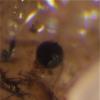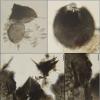
06-12-2025 00:19
 Viktorie Halasu
Viktorie Halasu
Hello, would anyone have this article, please? An

05-12-2025 17:33
 Bruno Coué
Bruno Coué
Bonjour, je serais heureux de recueillir votre avi

02-12-2025 18:59
This pair of ascos 2.5cm across were on recently b

02-12-2025 19:25
Buckwheat PeteHello, can anyone identify this hairy fungus growi

30-11-2025 12:53
 Edvin Johannesen
Edvin Johannesen
White short-stipitate apothecia found on thin twig

30-11-2025 10:47
 William Slosse
William Slosse
I recently found a collection of small Peziza sp.
Capronia
Gernot Friebes,
05-07-2010 22:47
again a pyreno. :)
It's a Capronia which I found on the underside of a decorticated branch of Fagus sylvatica lying on the ground together with Mollisia spec. and Orbilia delicatula. According to the paper by Müller et al. this find should be around coronata/pilosella. There is also C. moravica but I think that for this species the form and the size of the spores don't fit too well, neither does the original description by Petrak or the description by Munk.
I think that C. coronata and C. pilosella fit better but my problem is that I don't know how to distinguish these two species. Both have setae around the ostiole and the size of the ascospores is quite similar...
The size of the ascospores of my find is 12-13,5(15) x 4-4,5 µm and they are three-septate. The ascomata were really tiny with a diameter of some 100 µm and apparently smooth until you see them under the microscope. The asci are 8-spored.
Best wishes,
Gernot
Gernot Friebes,
05-07-2010 22:50
Hans-Otto Baral,
05-07-2010 23:55

Re:Capronia
Hi Gernot
a bad genus which you try to work on :-/
At least you can try the Lugol reaction. In our (Guy's and mine) experience many Capronias react hemiamyloid (red, blue after KOH) in their ascus gel, but not all, and not all in the same intensity. Regrettably, the literature is quite empty concerning this feature (because of the usage of Melzer).
Zotto
a bad genus which you try to work on :-/
At least you can try the Lugol reaction. In our (Guy's and mine) experience many Capronias react hemiamyloid (red, blue after KOH) in their ascus gel, but not all, and not all in the same intensity. Regrettably, the literature is quite empty concerning this feature (because of the usage of Melzer).
Zotto
Thomas Læssøe,
06-07-2010 10:16
Re:Capronia
Untereiner (e.g. 1997, Mycologia 89(1): 120-131) synonymize C. moravica with C. pilosella, but apparently has nothing so say on C. coronata. It was not included in the Barr key either (Barr 1991, Mycotaxon 41(2): 419-436). Samuels (in Müller et al.1987) does not discuss his New Zealand taxon in relation to pilosella, but does key it out next to this species with a minor difference in spore dimensions.....
Gernot Friebes,
06-07-2010 17:21
Re:Capronia
Hi,
thanks to both of you!
@Zotto: Unfortunately I didn't try lugol and now there are hardly any ascomata left. But I'll think of it in the future.
@Thomas: The paper by Untereiner is new to me and it's interesting that she synonymizes C. moravica with C. pilosella. I think it's strange that Samuels decribes a new species apparently very close to C. pilosella but doesn't write about how to distinguish them. The key isn't very helpful for this problem either. The only big difference seems to be the anamorph (Cladosporium-like anamorph C. pilosella vs. Exophiala anamorph in C. coronata),
Best wishes,
Gernot
thanks to both of you!
@Zotto: Unfortunately I didn't try lugol and now there are hardly any ascomata left. But I'll think of it in the future.
@Thomas: The paper by Untereiner is new to me and it's interesting that she synonymizes C. moravica with C. pilosella. I think it's strange that Samuels decribes a new species apparently very close to C. pilosella but doesn't write about how to distinguish them. The key isn't very helpful for this problem either. The only big difference seems to be the anamorph (Cladosporium-like anamorph C. pilosella vs. Exophiala anamorph in C. coronata),
Best wishes,
Gernot


